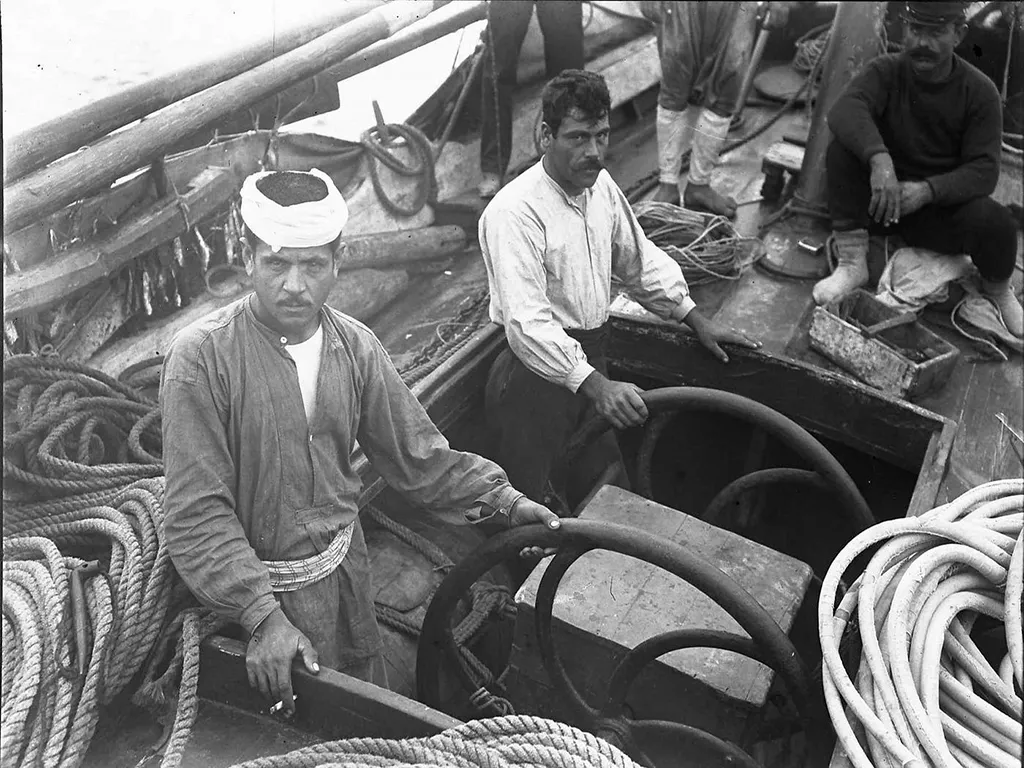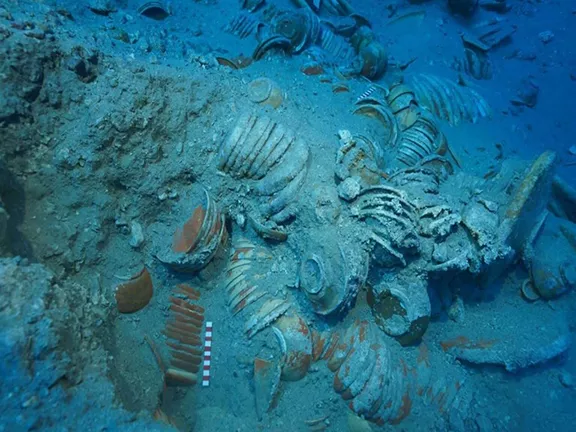Roman Era Shipwrecks in the Mediterranean
Kyrenia Shipwreck: 4th Century BC Greek Merchant Ship & Hellenistic Trade
The Kyrenia Shipwreck is a remarkably well preserved 4th-century BC Greek vessel excavated by Michael Katzev off Cyprus. We examine its valuable cargo of Rhodian amphoras, Syrian glassware, and its unique Hellenistic 'shell-first' construction method.
By Nick Nutter on 2025-10-31 | Last Updated 2025-11-2 | Roman Era Shipwrecks in the Mediterranean
This article has been visited 321 times

Kyrenia Shipwreck Museum
The Kyrenia Shipwreck: A Glimpse of Fourth-Century BC Maritime Trade
Discovered off the coast of Cyprus, the Kyrenia shipwreck represents the remarkably well preserved remains of an ancient Greek merchant vessel, which sank around 295 to 285 BC. This coastal freighter, found near Kyrenia harbour, offers insights into both Hellenistic shipbuilding and the extensive trade networks of the Eastern Mediterranean.
Do you enjoy my articles? For your reading pleasure, this website does not carry third party ads. You could help me write more articles by buying me a cup of coffee.
Discovery and Scientific Excavation
Greek-Cypriot diving instructor Andreas Cariolou first discovered the wreck in November 1965 during a storm. Resting at a depth of approximately 33 metres (108 feet), the site attracted international attention. A team of archaeologists from the University of Pennsylvania Museum of Archaeology and Anthropology subsequently excavated the shipwreck in 1968 and 1969. Michael Katzev, who later co-founded the Institute of Nautical Archaeology, led the pioneering underwater excavation.
Ship Design and Construction
The Kyrenia ship is a small, single-masted vessel, measuring about 14 metres (47 feet) long with a beam of approximately 4.4 metres (14 feet). Built primarily of pine and cedar, the ship's hull was protected with a mixture of resin and hair as caulking, and later entirely sheathed in lead, the first known example of this type of hull protection.
Architectural analysis identifies the ship as the prototype of the Hellenistic architectural system. Builders constructed the hull using a 'shell-first' method, employing carvel planking assembled with numerous mortise-and-tenon joints. The framing system featured alternating floor timbers and half frames, nailed to the planking for structural integrity. The vessel was designed with a wine-glass cross-section and was equipped with a single square sail and a rudder. Extensive repairs visible on the shell suggest the ship enjoyed many seaworthy years, about forty years if the date of its demise is correct, after its likely construction date of around 325 to 315 BC.
To date (2025), three Kyrenia replicas have been produced and launched, and these reconstructions have yielded considerable information on ancient ships and their sailing performance.
Cargo and Mediterranean Commerce
The ship’s cargo illustrates its extensive trade route. It carried approximately 500 amphoras used for transporting goods such as wine, olive oil, fish sauce, and almonds. The stamps on these clay amphoras clearly show origins from major Greek trading centres, most commonly Rhodes, but also including Athens and Corinth.
Beyond the bulk commodities, the vessel also transported a variety of other valuable artefacts:
• Dining wares from Cyprus and Greece.
• Tools and ship's rigging.
• Glassware from Syria, including high-quality core-formed bowls, jugs, and lamps, suggesting the ship participated in the lucrative trade of luxury items.
The valuable nature and volume of the amphoras lead some historians to argue that a wealthy merchant or family likely owned and operated the vessel. The mixture of trade goods and personal items suggests the crew maintained a relatively comfortable lifestyle while sailing.
Origin, Destination, and Crew
The ship's exact route and crew origin remain subjects of debate among historians, though the evidence provides strong suggestions. The prevalence of Rhodian stamps on the cargo suggests that the vessel may have originated from Rhodes and was likely sailing toward Cyprus when it sank. It may have also been trading with cities in Greece and Egypt via routes across the Aegean Sea and the Eastern Mediterranean.
Similarly, while the ship's owners and operators remain unknown, the archaeological findings suggest a crew of Greek origin, given the ship's location near a Greek colony and the Greek provenance of the majority of the cargo. However, a mixed Greek and Cypriot crew remains a possibility, reflecting Cyprus's multicultural society during the 4th century BC.
Ultimately, the Kyrenia shipwreck provides a tangible record of the maritime trade that defined the ancient Hellenistic world.
Where to see the Kyrenia wreck and artefacts
The restored remains of the 3rd century BC Kyrenia shipwreck can be seen at the Ancient Shipwreck Museum inside Kyrenia Castle in Northern Cyprus. The museum displays the ancient Greek merchant vessel's hull, which was reconstructed after being salvaged from the seabed.
In addition to the ship's hull, the museum also exhibits numerous artifacts recovered from the wreck, such as amphorae, almonds, millstones, and other provisions.
References
The Kyrenia Ship Final Excavation Report, Volume I, by Michael Katzev and Donald Harden (Oxbow Books, 1982).
The Kyrenia Ship: An Introductory Guide, by the Cyprus Museum (Cyprus Museum, 2008).
"The Kyrenia Shipwreck: A Brief History," by the Institute of Nautical Archaeology (INA, 2019).
Katzev, M. L., and D. B. Harden. 1982. The Kyrenia Ship: Final Excavation Report, Volume I. Oxford: Oxbow Books.
Katzev, M. L., and H. W. Swiny. 2008. The Kyrenia Ship: An Introductory Guide. Nicosia: Cyprus Museum.
Manning, Sturt & Lorentzen, Brita & Bridge, M. & Dee, Michael & Southon, John & Wenger, Madeleine. (2024). A revised radiocarbon calibration curve 350–250 BCE impacts high-precision dating of the Kyrenia Ship. PLOS ONE. 19. 10.1371/journal.pone.0302645.
Steffy, J. R. 1985. The Kyrenia Ship: An Interim Report on the Conservation and Reconstruction of a 4th Century B.C.E. Greek Merchant Vessel. College Station: Texas A&M University Press.
Swiny, H. W. 1984. "The Cargo of the Kyrenia Ship: A Preliminary Report." In The Seaborne Commerce of Ancient Rome: Studies in Archaeology and History, edited by J. H. D'Arms and E. C. Kopff, 115-134. Rome: American Academy in Rome.
Williams, D. 1983. "The Kyrenia Ship: The Cargo." The International Journal of Nautical Archaeology 12 (2): 117-137.
"The Maritime Trade of Ancient Greece," by John Boardman (Thames and Hudson, 1971).
"The Ancient Mediterranean Economy," by Peter Garnsey, Keith Hopkins, and C. R. Whittaker (Routledge, 1983).
Do you enjoy my articles? For your reading pleasure, this website does not carry third party ads. You could help me write more articles by buying me a cup of coffee.
 1: The Komiža Shipwreck (400 – 300 BC)
1: The Komiža Shipwreck (400 – 300 BC) 3: Marsala shipwreck (c 250 BC) Sicily
3: Marsala shipwreck (c 250 BC) Sicily 4: Mahdia Shipwreck 80–70 BC
4: Mahdia Shipwreck 80–70 BC 5: Antikythera Shipwreck 60 - 50 BC
5: Antikythera Shipwreck 60 - 50 BC 6: Adrasan Plate wreck c 50 - 20 BC
6: Adrasan Plate wreck c 50 - 20 BC